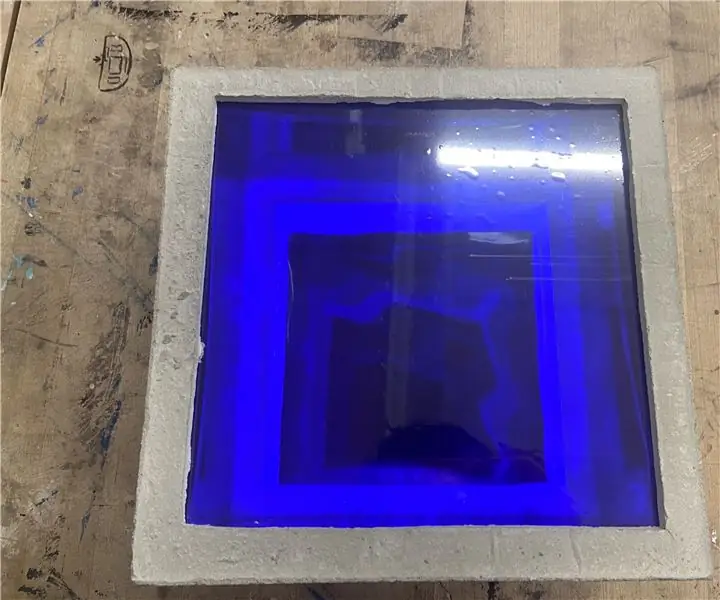
INHOUDSOPGAWE:
- Outeur John Day [email protected].
- Public 2024-01-30 07:25.
- Laas verander 2025-01-23 12:53.

Dit is 'n kunswerk van 'n LED -ligapparaat vir my beeldhouprojek met die naam Sacred Object. Ek gebruik hierdie toestel om 'n inskrywing vir 'n nuwe wêreld voor te stel. As ek die LED -lig aanskakel, kan ons 'n oneindige tonnel in die betonboks sien. Die LED -strook word via bluetooth op my telefoon beheer. Ek het alle voorrade op Amazon gekoop.
Materiaal:
- Arduino Uno
-LED strook
-9v battery
-DSD Tech SH-HC-08 Bluetooth 4.0 BLE slaafmodule
-330 Ohm weerstand
- iPhone
-Beton
-Akriel
-Venster film (eenrigting spieël)
-Dubbele syspieëlfilm
Stap 1: Kringontwerp
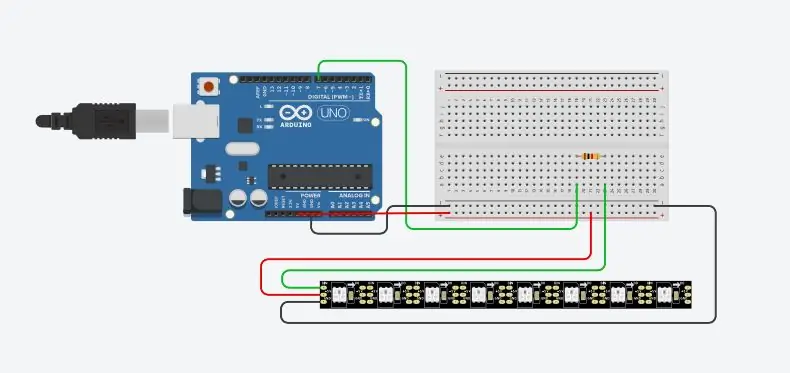

Dit is hoe ek die stroombaan laat werk. Ek het ook 'n volgorde geskep om 'n beweging van breingolwe te simuleer.
Die eerste prentjie is die LED -strookbaan.
Die tweede beeld is die Bluetooth -kring. Die app op iPhone is BluetoothLED.
Stap 2: Arduino -kode
#insluit
#define LED_PIN 7 #define NUM_LEDS 60 CRGB leds [NUM_LEDS];
ongeldige opstelling () {pinMode (LED_PIN, OUTPUT); Serial.begin (9600); FastLED.addLeds (leds, NUM_LEDS); }
void setBlue (int val) {for (int i = 0; i <NUM_LEDS; i ++) {leds = CRGB (0, 0, val); } FastLED.show (); } leemte lus () {
as (Serial.available ()) {val = Serial.read (); } as (val == 'H') {leds [0] = CRGB (0, 0, 0); FastLED.show (); leds [1] = CRGB (0, 0, 0); FastLED.show (); leds [2] = CRGB (0, 0, 0); FastLED.show (); leds [3] = CRGB (0, 0, 0); FastLED.show (); leds [4] = CRGB (0, 0, 0); FastLED.show ();
leds [5] = CRGB (0, 0, 0); FastLED.show ();
leds [6] = CRGB (0, 0, 0); FastLED.show ();
leds [7] = CRGB (0, 0, 0); FastLED.show ();
leds [8] = CRGB (0, 0, 0); FastLED.show ();
leds [9] = CRGB (0, 0, 0); FastLED.show ();
leds [10] = CRGB (0, 0, 0); FastLED.show ();
leds [11] = CRGB (0, 0, 0); FastLED.show ();
leds [12] = CRGB (0, 0, 0); FastLED.show ();
leds [13] = CRGB (0, 0, 0); FastLED.show ();
leds [14] = CRGB (0, 0, 0); FastLED.show ();
leds [15] = CRGB (0, 0, 0); FastLED.show ();
leds [16] = CRGB (0, 0, 0); FastLED.show ();
leds [17] = CRGB (0, 0, 0); FastLED.show ();
leds [18] = CRGB (0, 0, 0); FastLED.show ();
leds [19] = CRGB (0, 0, 0); FastLED.show ();
leds [20] = CRGB (0, 0, 0); FastLED.show ();
leds [21] = CRGB (0, 0, 0); FastLED.show ();
leds [22] = CRGB (0, 0, 0); FastLED.show ();
leds [23] = CRGB (0, 0, 0); FastLED.show (); leds [24] = CRGB (0, 0, 0); FastLED.show ();
leds [25] = CRGB (0, 0, 0); FastLED.show ();
leds [26] = CRGB (0, 0, 0); FastLED.show ();
leds [27] = CRGB (0, 0, 0); FastLED.show ();
leds [28] = CRGB (0, 0, 0); FastLED.show ();
leds [29] = CRGB (0, 0, 0); FastLED.show ();
leds [30] = CRGB (0, 0, 0); FastLED.show (); leds [31] = CRGB (0, 0, 0); FastLED.show ();
leds [32] = CRGB (0, 0, 0); FastLED.show ();
leds [33] = CRGB (0, 0, 0); FastLED.show (); leds [34] = CRGB (0, 0, 0); FastLED.show ();
leds [35] = CRGB (0, 0, 0); FastLED.show ();
leds [36] = CRGB (0, 0, 0); FastLED.show ();
leds [37] = CRGB (0, 0, 0); FastLED.show ();
leds [38] = CRGB (0, 0, 0); FastLED.show ();
leds [39] = CRGB (0, 0, 0); FastLED.show ();
leds [40] = CRGB (0, 0, 0); FastLED.show ();
leds [41] = CRGB (0, 0, 0); FastLED.show ();
leds [42] = CRGB (0, 0, 0); FastLED.show ();
leds [43] = CRGB (0, 0, 0); FastLED.show (); leds [44] = CRGB (0, 0, 0); FastLED.show ();
leds [45] = CRGB (0, 0, 0); FastLED.show ();
leds [46] = CRGB (0, 0, 0); FastLED.show ();
leds [47] = CRGB (0, 0, 0); FastLED.show ();
leds [48] = CRGB (0, 0, 0); FastLED.show ();
leds [49] = CRGB (0, 0, 0); FastLED.show ();
leds [50] = CRGB (0, 0, 0); FastLED.show ();
leds [51] = CRGB (0, 0, 0); FastLED.show ();
leds [52] = CRGB (0, 0, 0); FastLED.show ();
leds [53] = CRGB (0, 0, 0); FastLED.show (); leds [54] = CRGB (0, 0, 0); FastLED.show ();
leds [55] = CRGB (0, 0, 0); FastLED.show ();
leds [56] = CRGB (0, 0, 0); FastLED.show ();
leds [57] = CRGB (0, 0, 0); FastLED.show ();
leds [58] = CRGB (0, 0, 0); FastLED.show ();
leds [59] = CRGB (0, 0, 0); FastLED.show ();
vertraging (100); } anders {vir (int i = 255; i> 0; i--) {setBlue (i); vertraging (10); } vir (int i = 0; i <255; i ++) {setBlue (i); vertraging (10); }}}
Stap 3: Maak houer
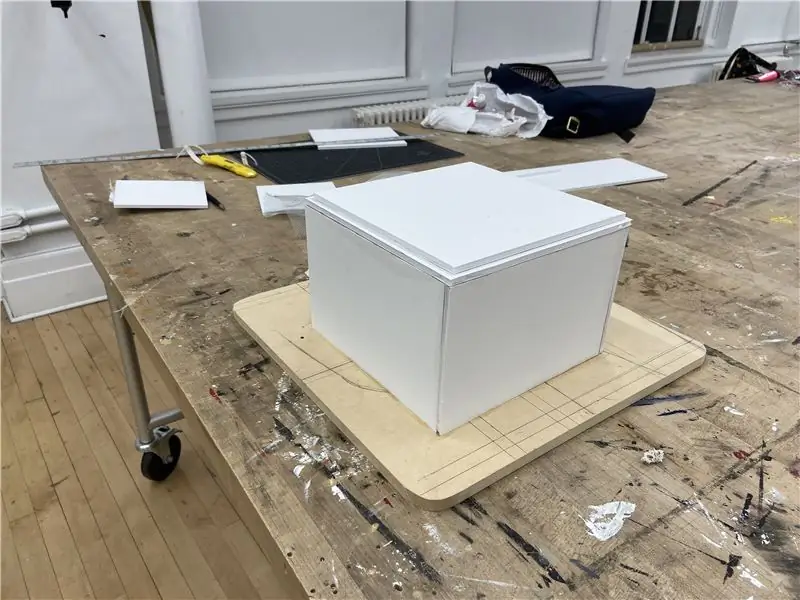
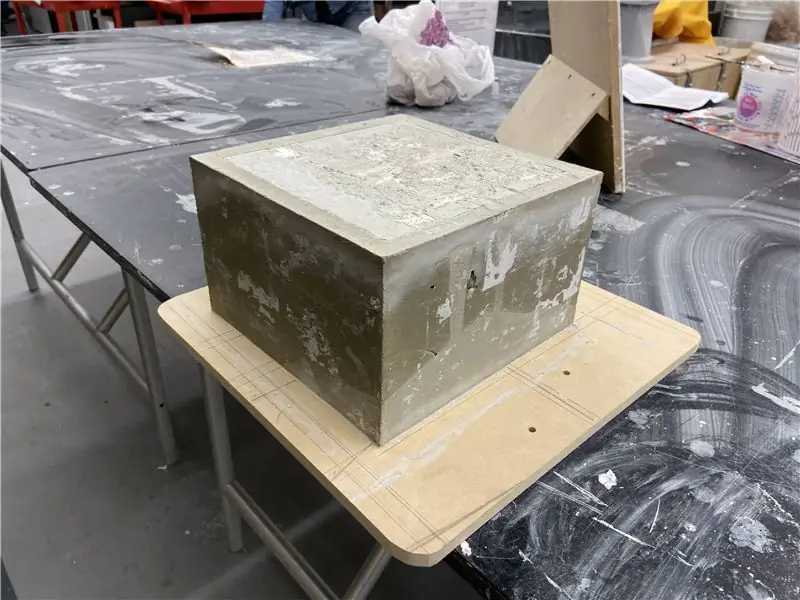
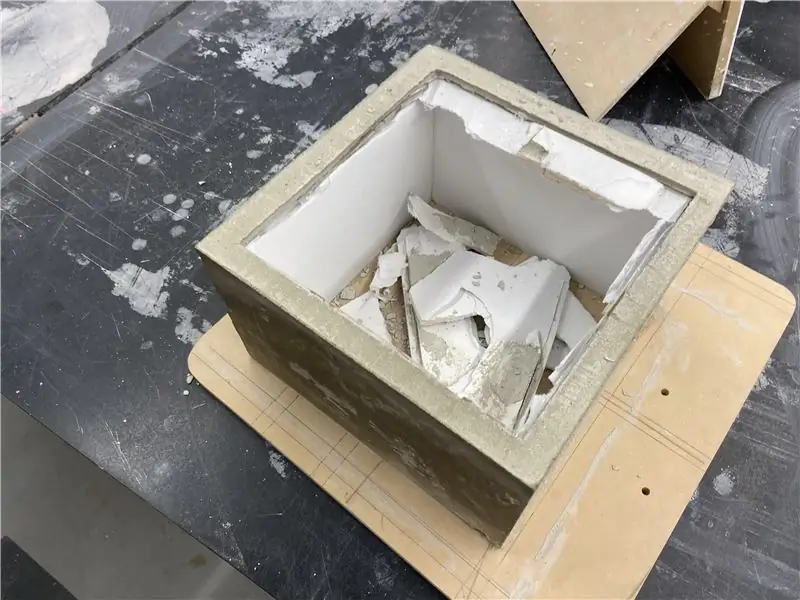
Die boks is gemaak van beton. Ek gebruik skuimplanke om 'n hol boks te maak om met beton te giet. Laat dit ten minste 24 uur droog word.
Stap 4: Lasersny
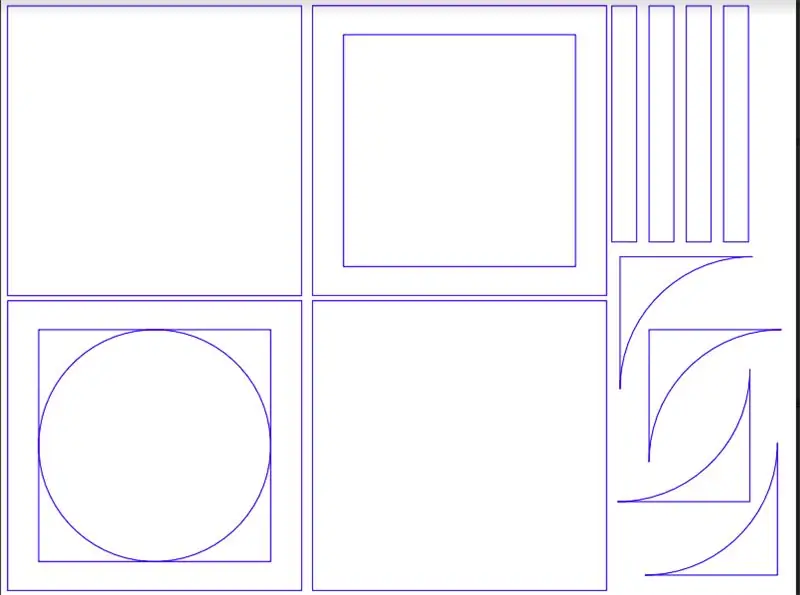
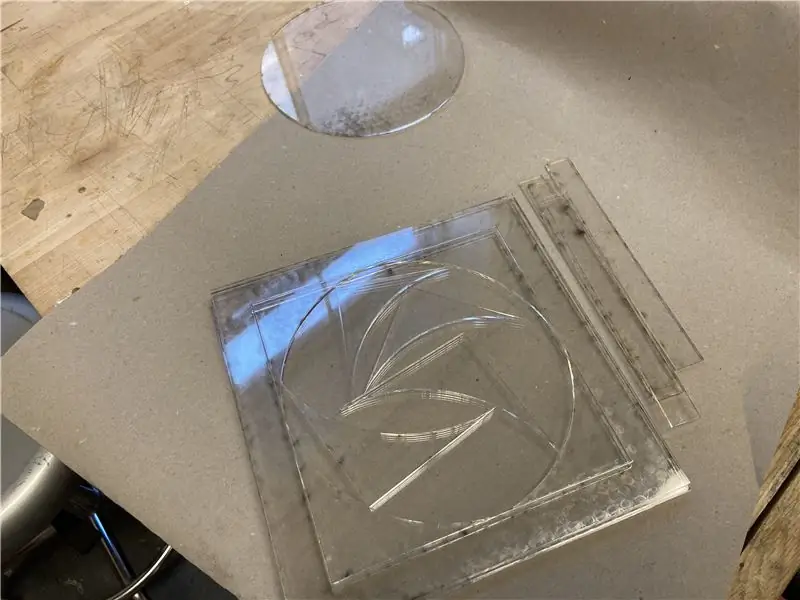
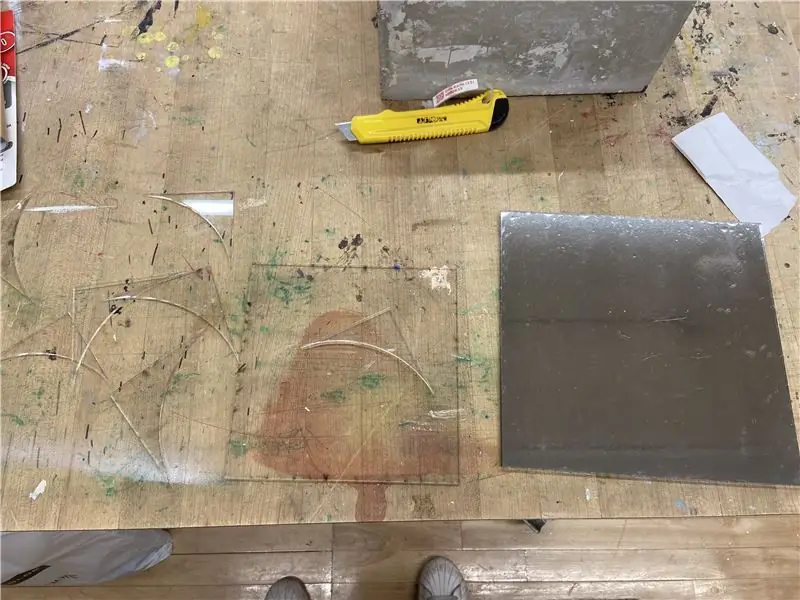
Om die vorm te teken, pas in die betondoos en sny dit met lasersnit.
Ek gebruik dit om verskillende ruimtes in die boks te laag: die weerkaatsingsruimte en die kringruimte. Ek sit elke spieëlvensterfilm en dubbelkantspieëlfilm op die akrielvierkante elk.
Stap 5: LED -strook
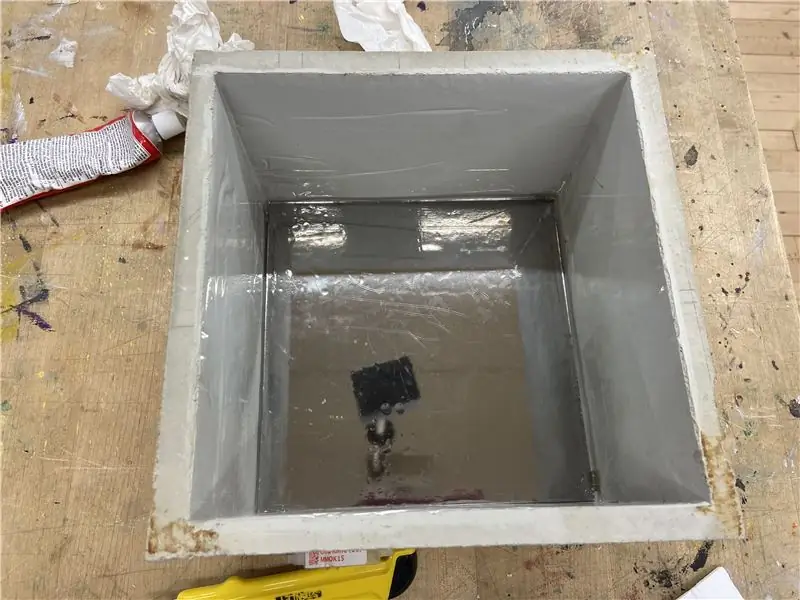
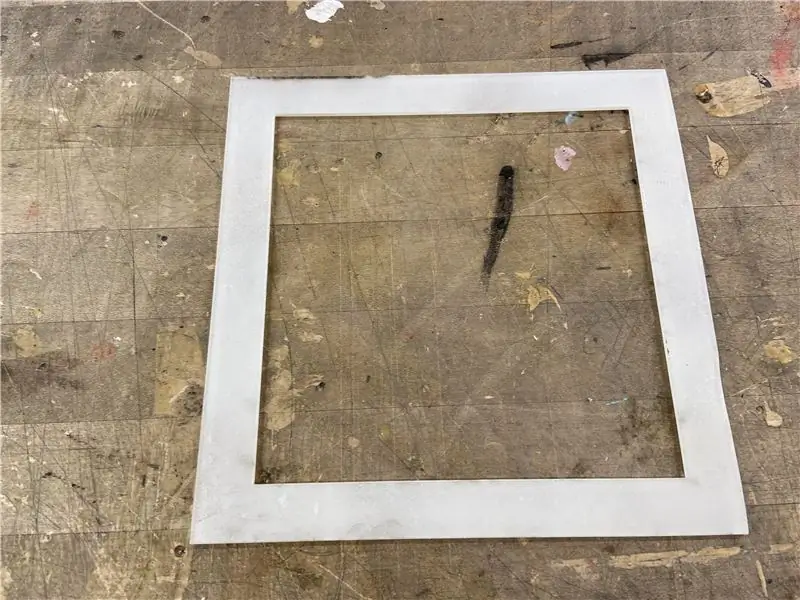
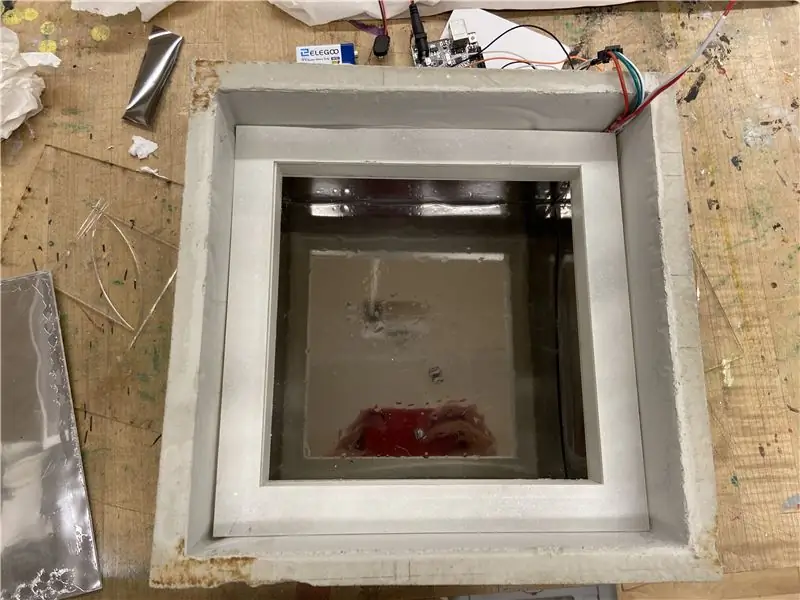
(Uitsig onderaan die boks)
Ek plaas die eenrigting spieëlfilm een eerste, die kant van die spieël in die boks. Spuit 'n wit kleur op die raam om 'n buis met 'n halfdeursigtigheid vir die LED-strook te skep en plaas dit in die middel van die boks.
Stap 6: Kringloop
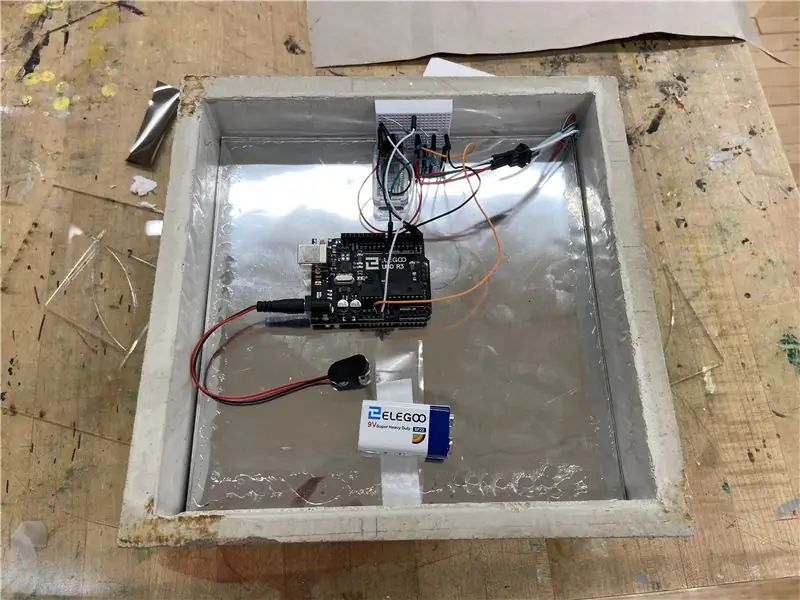
Sit die dubbelkantspieël akriel bo -op die LED en heg die stroombaan aan.
Aanbeveel:
Toegang tot u Solaredge -data met behulp van Python: 4 stappe
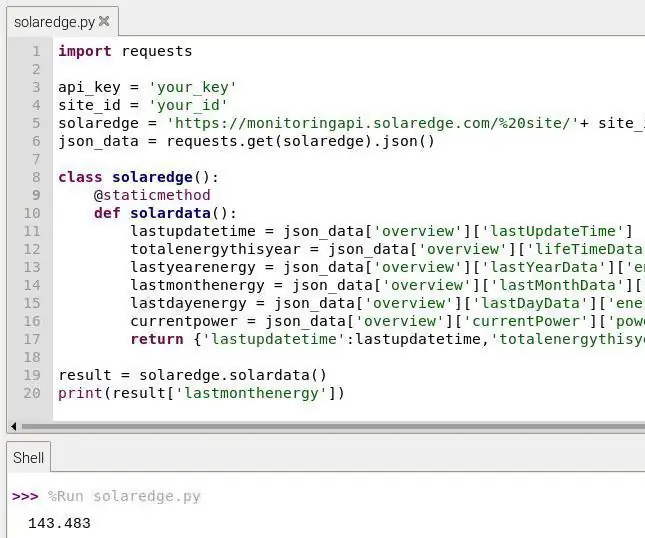
Toegang tot u Solaredge -data met behulp van Python: Omdat die data van die solaredge -transformators nie plaaslik gestoor word nie, maar op die bedieners van solaredge wou ek my data plaaslik gebruik, op hierdie manier kan ek die data in my eie programme gebruik. Ek sal u wys hoe u u data op die solaredge -webwerwe kan aanvra
Toegang tot u gedagtes kwantifiseer: 8 stappe (met foto's)
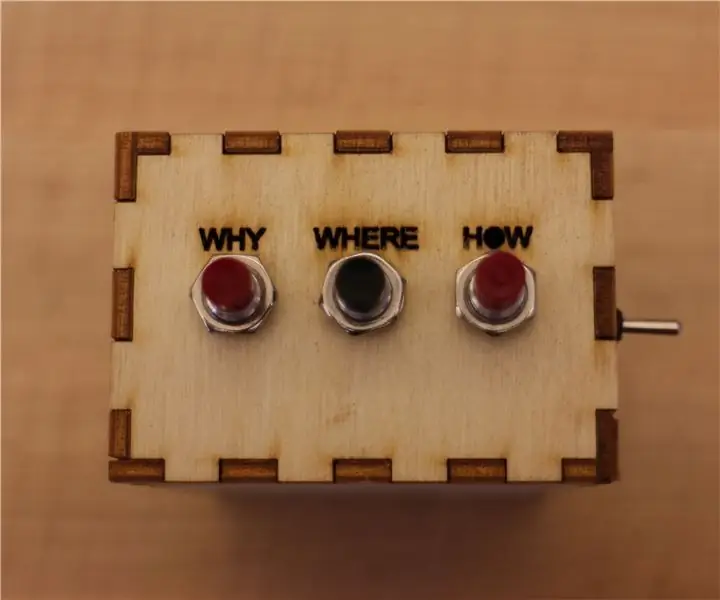
Toegang tot u gedagtes kwantifiseer: Ek bestuur dus 'n kreatiewe tegnologie -laboratorium aan die California College of the Arts. Dit is in wese 'n opvoedkundige hackerspace vir kuns- en ontwerpstudente. Redelik wonderlik, reg? Na afstuderen aan die Universiteit van Minnesota met 'n graad in meganiese
Toegang tot eksterne wortellêersisteem met behulp van DB410 as 'n Ethernet -Dongle: 6 stappe
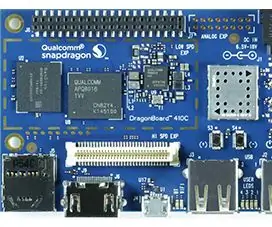
Toegang tot eksterne wortellêersisteem met behulp van DB410 as 'n Ethernet -Dongle: Doelwitte: Installeer werktuigketting en stel die kern weer saam om USB Ethernet CDC Gadget -ondersteuning in te voeg; Herskep boot.img van Linaro om USB Ethernet CDC op te laai; Skep NFS -bediener om die wortellêerstelsel te huisves; IP -opset in DEVICE en HOST
Beheer toegang tot Arduino YÚN met MySQL, PHP5 en Python: 11 stappe (met foto's)
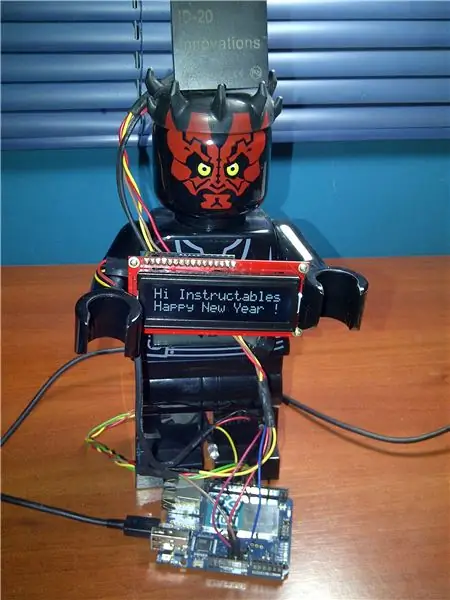
Beheer toegang tot Arduino YÚN met MySQL, PHP5 en Python: Hallo vriende! Soos u weet, in September die nuwe premierskild van Arduino, Arduino YUN. Hierdie vriendin het 'n Linux -ingeboude stelsel waarmee ons alles kan uitvoer waaraan u kan dink (ten minste tot dusver). Alhoewel daar baie min inligting is
Handmatige toegang tot GPS Ublox Neo 6M met Framboos Pi B+: 3 stappe

Handmatige toegang tot GPS Ublox Neo 6M Met Raspberry Pi B+: Raspberry Pi is 'n baie versoenbare mini -rekenaar vir verskillende modules wat redelik maklik is om te gebruik. Eintlik is dit byna dieselfde as 'n rekenaar, maar kan beheer word met GPIO van Raspberry Pi. Raspberry Pi word ook ondersteun deur verskeie kommunikasiekanale, een van
